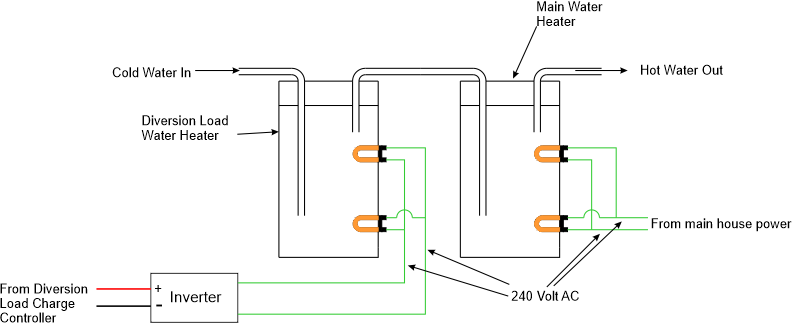Using a hot water heater as a diversion load is a great way to protect your wind power equipment while harnessing extra energy. If you decide to do so, it helps to know why you need a diversion load in the first place. It also helps to know why a hot water heater makes a good diversion load, and how to use a hot water heater as a diversion load. This means knowing how to set up a diversion load, as well as how to configure a hot water heater as that diversion load. There are many ways to do these things, and I will cover the ones that I believe are simplest.
Here is why you need a diversion load.
The wind can over-speed and destroy a wind turbine if there is no load for the turbine to power. This can happen to an off-grid system if the batteries are full and there is not enough power consumption in the home. The same thing can happen to a hybrid system that acts like an off-grid system during a grid outage.
Whenever a wind turbine is spinning, it must produce power for a load. Otherwise, it can either over-speed the wind turbine or over-charge the batteries. If the batteries are full and the house loads are too low, then the excess energy must go toward powering an artificial load. The artificial load goes by the term “diversion load” or “dump load”. It gets these names because it is diverting the excess energy to something useful or harmless, or it is dumping it as waste heat. Solar panels have no moving parts, so they do not face these issues.
Here is why a hot water heater makes a good diversion load.
Your system can either put the excess energy to good use or discard it. But some uses of the excess energy are only good during some seasons. For example, a space heater is only useful in cold weather and is a liability in hot weather. A water heater is an exception because it is useful in all seasons. After all, people still like hot showers even in the summer.
Here is how to set up a diversion load with a hot water heater.
Setting up a hot water heater involves 2 processes. The first is setting up a diversion load, and the second is using a hot water heater as the diversion load.
Here is how to set up a diversion load.
There are many ways to set up a diversion load. The manufacturer of a diversion load charge controller recommends one good way to do this. This method recommends connecting the charge controller input in parallel with the wind turbine output and the inverter input to the battery. The diversion load output terminals of the charge controller will connect to the diversion load. Here are some details to make this method work:
The wind turbine output voltage, the charge controller input voltage, the inverter input voltage, and the battery voltage must be compatible. For example, if the battery is a 48 volt battery, then everything must be compatible with a 48 volt system. This includes the bulk and float charging voltages of the charge controller.
Make sure that the charge controller is compatible with the battery chemistry. Many diversion load charge controllers are for lead-acid batteries. If you are using one of these types of controllers with a lithium-ion battery bank, here are some things to do:
Make sure that the bulk setting for the charge controller is at or below the high cut-off voltage for the battery.
Make sure that the float setting for the charge controller is close to but higher than the fully charged battery voltage.
If it has a battery equalization setting, disable it.

Some other types of diversion load charge controllers have separate terminals for each type of input and output. These make the setup even simpler. Make sure that the diversion load charge controller can handle the output from the wind turbine. Also, make sure that the diversion load can handle the output from the diversion load charge controller. Multiply the bulk charging voltage by the maximum amperage of the charge controller to find the wattage rating needed by the diversion load. You can also check the maximum wattage rating for the wind turbine. If the numbers differ, use the higher of the two.
Here is how to use a water heater as a diversion load.
This assumes that you already have a water heater if you are adding wind power to your home. In this case, it makes sense to put a second water heater upstream of your main water heater. This second water heater will be the diversion load and will pre-heat the water that is going to the main water heater. The main water heater will need to add less heat to maintain the desired temperature. Also, you wouldn’t need to change your main water heater, even if it is a gas water heater. The downside is that it takes up extra space.
There are 2 basic ways to use the diverted power to heat the water:
The first way is to modify the diversion load water heater to use DC power.
The second way is to get an inverter to convert the DC to AC power.
Here are some reasons why the second way might be the better option:
You won’t void the warranty on the diversion load water heater.
You can use any cheap inverter that has the necessary voltage and wattage ratings.
You will not need large conductor cables as you would for the lower DC voltage.
You won’t need to do as much work to set up the water heater.

In summary, you will need a diversion load for a wind turbine to prevent it from over-charging the batteries or from over-speeding itself. Diverting excess energy prevents it from damaging things, and you might as well divert it into something useful. A water heater is useful in a wide variety of situations and makes a great diversion load. Make sure that the different components are compatible with each other, and that you follow the manufacturers’ instructions. It also helps to choose the simplest options that work.
